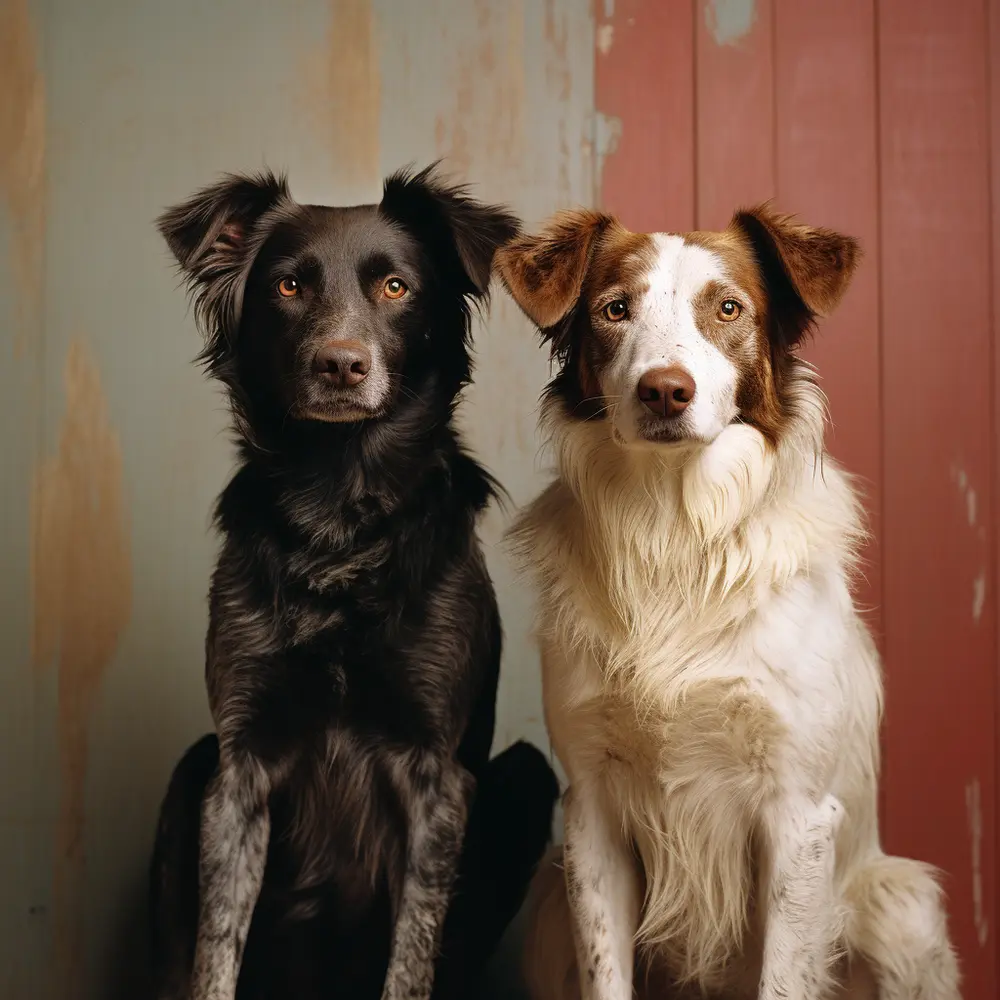Table of Contents:
Understanding the Differences: Male Dog vs Female Dog
When deciding between a male dog vs female dog, it's imperative to understand that both can provide companionship and joy, yet they may exhibit distinct characteristics. These differences are not just biological, but can also influence their interaction with you and the environment around them. It's not merely a choice of gender; it's about understanding the nuances that might fit better within your home and lifestyle.
One key difference lies in size. Generally, male dogs tend to be larger than their female counterparts across many breeds, although this can vary widely and should be considered alongside breed characteristics. Their larger stature might influence factors such as space requirements and food consumption.
Personalities also vary, with male dogs often being perceived as more playful and energetic. They may require more space to explore and could benefit from a more active lifestyle. It's also worth mentioning that un-neutered males can exhibit behaviours like territory marking and roaming if not managed appropriately through training and possible neutering.
On the other hand, female dogs are typically known to mature faster, which could influence training and integration into the family. They may show a higher degree of attentiveness and calmness once they've matured, which some owners might prefer, depending on their daily life and household dynamics.
Ultimately, while these differences are worth considering, each dog is unique and their individual personality, upbringing, and training often play a more significant role in determining the right fit for your family than their gender alone.
Physical and Size Considerations in Choosing a Dog
When considering the physical and size aspects of choosing between a male and female dog, it's crucial to delve beyond the general size disparity. Specific breed standards can provide insight into the expected size range for both genders, but actual size can also be influenced by diet, health, and genetics, making it important to look at the parents.
The space in your home and yard should align with the needs of your dog's size. Large dogs will need more room to move around comfortably and more robust toys and equipment that can withstand their strength. If you’re living in a smaller space, such as an apartment, smaller or more docile breeds, irrespective of gender, could be more suitable.
Exercise requirements are another point to consider. A larger dog may necessitate longer walk times and more vigorous play sessions to stay healthy and content. In contrast, smaller dogs can typically make do with shorter, more frequent outings. These factors are pivotal in maintaining a happy and healthy dog.
Just as with humans, each dog will have its own set of physical and health needs, which often go beyond gender considerations. Looking at the individual dog, their mother and father, and even their siblings can give a clearer picture of what to expect in terms of their full-grown size and overall health predispositions.
Comparing Male and Female Dogs: Traits and Considerations
| Consideration | Male Dog | Female Dog |
|---|---|---|
| Temperament | Often more playful and extroverted | Tend to be more reserved and independent |
| Trainability | May be more easily distracted during training | Often quicker to mature and can focus better during training |
| Marking Behavior | More prone to marking their territory | Less likely to engage in marking, but it can still occur |
| Size | Generally larger than females of the same breed | Typically smaller and may be easier to handle physically |
| Health Considerations | Some health issues like prostate problems can occur | Possible complications with heat cycles and pregnancy |
| Social Dynamics | Can be more territorial, especially with other males | May get along better with male dogs, potential for conflict with other females |
| Spaying/Neutering | Neutering recommended to prevent unwanted behaviours | Spaying advised to prevent health risks and unwanted litters |
Behavioural Traits of Male and Female Dogs
The behavioural attributes of dogs are often a primary concern for potential pet owners. While each dog possesses a distinct personality, certain behavioural traits may be observed more frequently within a particular gender. Recognising these tendencies allows for a smoother integration of the dog into your domestic setting and daily routines.
Male dogs, when un-neutered, can be pushy and strong-willed, and can be prone to roaming, especially when they sense a female in oestrus nearby which can present challenges in unsecured outdoor spaces. Nonetheless, with consistent training and care, managing these traits is entirely possible.
Female dogs can be observed to be more reserved or independent at times. They might also exhibit nesting behaviours, particularly if they remain intact and experience oestrus cycles. Whilst these behaviours are normal to a degree, persistent nesting can indicate a hormonal upset such as phantom pregnancy. Understanding and anticipating these behaviours can help in providing a nurturing environment for a female dog.
Researchers have delved into these behavioural patterns and have highlighted the importance of socialisation. Early and consistent exposure to various people, dogs, environments, and situations can greatly mitigate the intensity of gender-specific behaviours, rendering the dog's sex a less decisive factor in its overall demeanour.
Ultimately, the behaviour of each dog will vary considerably based on individual temperament, upbringing, and experiences. Engaging with a dog prior to bringing them home, observing their reactions to different stimuli, and consulting with a professional can offer valuable insights and aid in matching you with a dog whose behaviour complements your lifestyle, regardless of whether they are male or female.
The Impact of Spaying and Neutering on Dog Behaviour
Spaying and neutering are surgical procedures that not only prevent dogs from breeding but also have significant impacts on their behaviour. These operations involve the removal of reproductive organs, which in turn, leads to a reduction in certain hormone-driven behaviours.
In male dogs, neutering can diminish the likelihood of roaming, as the urge to seek out mates is reduced. It can also lead to a decrease in aggressive behaviours towards other male dogs, and a lessened tendency to mark territory with urine, a trait that many owners find problematic.
For female dogs, spaying eliminates the heat cycles that can cause behavioural changes like restlessness and irritability. Moreover, it can prevent unwanted attention from male dogs, resulting in a more peaceful environment both for the female and for the household.
It's important to note that while spaying and neutering can influence a dog's behaviour, they are not a cure-all for behavioural issues. Effective training and socialisation are still crucial in fostering well-behaved dogs. Additionally, the timing of these procedures can vary based on individual health needs and the advice of a veterinary professional. Further still, neutering is not advised for dogs experiencing nervousness or for those that demonstrate aggression related to fear, as this can escalate the issue.
Owners should weigh the changes that might come with spaying or neutering against the benefits. When contemplating these permanent procedures, it is wise to have a thorough discussion with a vet and/or behaviourist to understand the full scope of potential behavioural impacts and health benefits.
Health Benefits and Considerations for Male and Female Dogs
Choosing between a male or female dog involves considering their respective health benefits and risks, which can be influenced by their gender. Understanding these health implications is important for providing the best care and for planning long-term support for your dog.
Spaying female dogs can lead to a decrease in the risk of developing mammary tumours and virtually eliminates the possibility of pyometra, a potentially life-threatening uterine infection. It also prevents the occurrence of ovarian and uterine cancers. However, the timing of the procedure should be assessed in conjunction with a professional to ensure optimal benefits, as early spaying may lead to other health considerations.
Neutering male dogs helps prevent testicular cancer and can reduce the risk of benign prostatic hyperplasia, a common condition in older intact males that affects the prostate gland. Additionally, neutering may reduce the risk of aggression-related injuries and certain types of hernias.
While these procedures contribute positively to the overall health of pets, they may also be associated with certain risks, including weight gain and, depending on the timing, an increased risk of orthopaedic issues. Owners should maintain a balanced diet and regular exercise regimen for their pets to mitigate these risks.
Making informed decisions about spaying and neutering, as well as understanding the broader spectrum of health concerns for each gender, depends on thorough discussions with a veterinary professional. They can offer tailored advice based on the dog's breed, age, and lifestyle, ensuring that your chosen pet leads a healthy, fulfilling life.
Training Differences Between Male and Female Dogs
When embarking on the rewarding challenge of training a dog, understanding potential differences between male and female canines can guide you toward a more effective and harmonious training experience. While individual temperament plays a major role, some general observations can be made about training across genders.
Females, with their quicker maturity rates, may respond to training with a heightened focus and could potentially grasp commands with greater speed.
Conversely, males sometimes exhibit a rambunctious nature that might require more patience and repetition during training sessions. Their playful spirit, when channeled correctly, can make the learning process enjoyable; however, consistency and clear-communication is imperative to maintain focus.
Regardless of the gender, positive reinforcement techniques such as rewards and praises are highly effective. They promote a trusting relationship and make learning a positive experience.
Overall, while there are nuanced differences in approaching training with male and female dogs, the principles of consistency, patience, and positive reinforcement remain central. Collaborating with a professional dog trainer or behaviourist can offer further personalised strategies for addressing the unique needs of your dog, ensuring a well-trained companion regardless of gender.
The Role of Personality in Selecting Your Ideal Dog
While gender may influence certain tendencies, the personality of a dog is a paramount aspect to consider when choosing a furry companion that aligns with your lifestyle and preferences. It surpasses the usual male dog vs female dog debate, focusing on individual traits that contribute to the compatibility between a pet and their owner.
Assessing a dog's temperament involves observing their behaviour in a variety of settings. Are they calm or anxious, sociable or aloof, independent or clingy? Compatibility with your own temperament and lifestyle is key. An active individual may find a perfect match in an energetic dog, while someone who enjoys a quiet environment may prefer a more docile pet.
Additionally, the readiness of a dog to learn, adapt to new environments, and interact with other pets or children can drastically influence the owner-pet relationship. Seeking the assistance of a professional when assessing a dog's personality can be incredibly helpful, as they can offer insights into the nuances of canine behaviour and predictability.
In the end, spending time with a potential pet, asking questions about their past interactions and behaviour, and even involving a professional assessment, can immensely aid in selecting the ideal dog. Choosing a companion based on personality rather than gender alone can lead to a more fulfilling and enjoyable pet ownership experience.
Managing Territorial Marking and Roaming in Male Dogs
Managing territorial marking and roaming can be a notable concern for owners of male dogs. These behaviours, often more prominent in males, stem from natural instincts but can be mitigated with proper guidance and techniques.
Diligent training is crucial in managing these behaviours. Consistent verbal cues and rewards for desired behaviour can teach male dogs acceptable ways to express their territorial instincts. Establish boundaries within your home where your dog can and cannot mark, (usually indoor vs outdoor). Utilise positive reinforcement to encourage your dog to understand these expectations.
Proper exercise and mental stimulation play a pivotal role in reducing excessive marking and roaming. Engaging your dog in activities that satisfy their need for exploration and marking within acceptable limits can mitigate these behaviours in the home environment.
For roaming, ensure that your yard is securely fenced, and consider leash training or the use of long leads during walks to curb the instinct to roam. Providing your dog with a safe and controlled way to explore can effectively satisfy their natural urges while keeping them out of harm's way.
If these territorial behaviours continue to pose a challenge, it may be beneficial to consult with a professional, particularly a behaviourist or trainer, who can offer more targeted strategies tailored to your dog's needs.
The Influence of Hormones on Dog Behaviour
The behaviour of dogs is significantly influenced by their hormonal makeup, with differences in behaviour often attributed to the hormones testosterone in males and oestrogen in females. Awareness and understanding of how these hormones affect behaviour are essential for managing and nurturing well-adjusted dogs.
Hormones can drive behaviours such as aggression, mating instincts, and territory marking. For instance, testosterone can contribute to more assertive and confident behaviours, which sometimes manifest in competitive interactions, particularly with other males.
Similarly, oestrogen has its effects, particularly evident when a female dog is in heat. During this time, a female may exhibit mood shifts, nesting, and may attract the attention of male dogs. These cyclical hormonal changes can shape how a female dog interacts with her environment.
Understanding these hormonal influences can assist dog owners in providing appropriate training, socialisation, and possibly medical intervention, such as spaying or neutering, to moderate intense behaviours driven by hormones.
Consulting with a veterinary professional regarding the timing and benefits of spaying or neutering can offer long-term behavioural advantages, reducing hormonally charged behaviours while also contributing positively to the dog's health.
Social Dynamics: Male and Female Dogs Living Together
The social harmony within a multi-dog household can depend on the understanding and management of the social dynamics between male and female dogs. The interaction of mixed-gender canine companions can vary greatly from one pair to another, but certain considerations can facilitate a smoother coexistence.
Introducing dogs of different sexes usually requires a careful, supervised approach. Gradual introductions in neutral spaces can allow each dog to adjust to the other's presence. Positive reinforcement during these meetings can help forge a friendly relationship.
Attention to each dog's individual needs for space and resources is key to preventing conflict. Providing separate resting areas, as well as individual toys and feeding stations, can help maintain peace by reducing competition and guarding behaviours.
Furthermore, spaying and neutering can decrease sexual tensions that might otherwise disrupt the household dynamics, making it easier for male and female dogs to live together peacefully.
Choosing the Right Dog for Your Lifestyle
Selecting the right dog for your lifestyle is an important decision that should align with your daily routine, energy level, and long-term commitments. Whether considering a male dog or a female, the key is to find a canine companion whose needs and characteristics complement your own.
Your lifestyle should determine the qualities you seek in a dog. Busy individuals or families might prefer a more independent dog, while those with ample leisure time may enjoy a dog that requires more engagement and interaction.
Consider your living arrangements. Do you reside in an apartment with limited space, or do you have a sprawling garden? The dog's potential size and energy level should be compatible with your home environment to ensure comfort for both you and your pet.
Reflect on the amount of time you can dedicate to exercising your dog. Active breeds will require more time outdoors and opportunities for physical exertion, while other breeds may be content with casual walks and indoor play.
Contemplate the future and possible changes to your lifestyle. Dogs are a long-term commitment; their needs must be anticipated over many years. Your readiness for this devotion is crucial when making a well-suited choice.
Finding the right dog can be a fulfilling process, and seeking advice from a professional in canine behaviour, a veterinarian, or a reputable breeder can provide valuable guidance tailored to help you make an informed and joyful decision.
The Myths and Facts About Male and Female Dog Behaviour
In the debate of male dog vs female dog behaviour, many myths circulate that can skew the expectations of prospective dog owners. Dispelling these myths and understanding the facts is crucial for a well-informed decision when choosing a new canine companion.
One common myth is that male dogs are always more aggressive and dominant than female dogs. While hormones can influence assertiveness, the fact is that aggression is not inherently linked to gender. Both male and female dogs can exhibit dominant or submissive personality traits, depending on their individual personality, training, and socialisation.
Another belief is that female dogs are less playful and more reserved than males. In reality, the playfulness of a dog often comes down to the breed and individual character rather than gender. Female dogs can be just as energetic and fun-loving as their male counterparts.
It is also frequently assumed that males are less affectionate and more independent than females. However, affection and bonding abilities are largely influenced by the attention, care, and nurturing provided by the owner from a young age. Both males and females are capable of forming strong, loving bonds with their humans.
When considering these myths, it is fundamental to note that every dog is unique, and broad generalisations do not accurately represent the vast array of canine temperaments and behaviours. Owners should focus on the observable traits of the individual dog and consult with a professional if they have specific behaviour concerns or questions.
Preparing for a Male or Female Puppy: What to Expect
Preparing for the arrival of a new puppy is an exciting time, but it's important to set realistic expectations whether you're welcoming a male or a female into your home. The right preparations can ease the transition for everyone involved.
Establish a puppy-safe environment, removing any hazards and securing areas where the puppy should not have access. Consider the necessary supplies such as a crate, bedding, suitable food, toys, and grooming products tailored to your puppy's expected size and coat type.
Be ready for the house-training process which requires patience and consistency. This involves setting a routine for feeding and toilet breaks, as well as establishing a designated area for the puppy to relieve itself.
Expect your puppy to need plenty of socialisation. Introduce them to different people, dogs, and environments progressively and positively to help them grow into well-adjusted adults.
Regardless of gender, puppies will test boundaries as they learn and explore. Training should start early, with simple cues to build communication and establish order in the home.
Anticipate the inevitable teething phase, and have appropriate chew toys ready to save your belongings from being gnawed on by your new furry family member.
Both male and female puppies will bring their unique personalities and challenges into your home. By making thoughtful preparations and committing to their training and care, you can look forward to the joys and rewards of raising a well-behaved and happy dog.
The Long-Term Commitment: Considering Dog's Lifespan and Care Needs
Adopting a dog is a joyous event, but it's also a significant commitment that spans the entirety of your pet's life. It's vital to contemplate the long-term care needs and lifespan of your future canine friend, ensuring you're prepared for the journey ahead.
Understanding that a dog's lifespan can vary depending on size, breed, and genetics is important. Smaller breeds tend to live longer lives, while larger breeds may have shorter lifespans. As your dog ages, their health and care needs will evolve, possibly requiring more frequent vet visits and accommodations for age-related conditions.
Financial readiness for pet ownership is another long-term consideration. Costs include routine vet care, food, grooming, training, and potential emergency health expenses. A budget should be in place to sustain the ongoing needs of your dog comfortably.
Mental and physical stimulation remains crucial throughout a dog's life. As they grow from an energetic puppy to a serene senior, their activity levels and interests may change, and it's essential to adapt accordingly.
Lastly, think about your own future and how a dog fits into it. Life circumstances such as moving, changes in work schedule, or growing family should be factored into your decision to ensure that you and your dog can maintain a stable, loving relationship for their entire life.
By considering these long-term aspects, you demonstrate a deep level of care and responsibility that will set the stage for a rewarding and enduring companionship with your dog.
Conclusion: Making an Informed Decision on Dog Gender Selection
In conclusion, when faced with the choice of male dog vs female dog, it is essential to make an informed decision that takes into account various considerations beyond gender stereotypes. By understanding the implications of each choice on aspects such as behaviour, health, and lifestyle compatibility, you are better equipped to select a dog that fits harmoniously within your home and life.
Remember that every dog is an individual, with their own quirks and personality traits. It is these personal characteristics, combined with your commitment to training, socialisation, and care, that will ultimately define your shared experience.
Before making a final decision, seek guidance from experienced professionals, interact with dogs of both genders, and consider your own lifestyle and preferences. Taking these steps will help ensure that your choice leads to a rewarding and enduring bond between you and your new companion.
Welcoming a new dog into your life is a significant and joyous responsibility. Regardless of whether you choose a male or a female dog, your dedication to love, nurture, and understand your pet is what will pave the way for a beautiful and fulfilling friendship.
Choosing Your Perfect Canine Companion: Male or Female?
What are the main behavioral differences between male and female dogs?
Male dogs are often more playful and energetic, and may exhibit behaviors such as territory marking and roaming if not neutered. Female dogs tend to mature faster, may focus better during training, and demonstrate reserved or independent behaviors more frequently than males.
Do male or female dogs require different training approaches?
While the fundamental principles of dog training are consistent across genders, male dogs may sometimes require more patience and repetition due to their playful nature. In contrast, female dogs might respond to training with greater focus due to their quicker maturity rates.
Are there any size differences between male and female dogs?
Yes, male dogs tend to be larger than females within the same breed, but size can also be influenced by factors like diet, health, and genetics. The size discrepancy may affect space requirements and food consumption.
How do spaying and neutering affect the behavior of dogs?
Spaying and neutering can lead to a reduction in hormone-driven behaviors such as territory marking, roaming, and aggression. Spaying eliminates heat cycles in females, leading to more consistent behavior, while neutering males may reduce tendencies to dominate and roam.
What should be considered when choosing between a male and female dog for a family pet?
Potential owners should consider the dog's personality, activity level, and compatibility with the family's lifestyle rather than focusing solely on gender. The presence of children, other pets, and the household's energy are all crucial to selecting a suitable dog.








